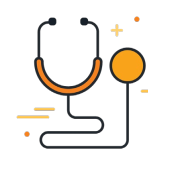October HeathE by Medica

HealthE by Medica
October is Breast Cancer Awareness Month
Every year, more than 260,000 women and nearly 2,500 men in
the U.S. are diagnosed with breast cancer —and black women have the highest
rate of death from the disease, according to the Centers for Disease Control(CDC). Some risk factors can’t be controlled, but
it’s crucial to be aware of which ones can, and the steps you can take for prevention and detection of the second most common
type of cancer for women in the U.S.
Tips for prevention:
- Exercise regularly. Lack of physical activity increases the chance of
breast cancer.
- Maintain a healthy weight. Individuals who have obesity are
at a higher risk of breast cancer and open face more complications during cancer treatment.
- Be aware of the risks of hormone treatment. Some hormone
replacement therapy methods and oral contraceptives
can raise the chance of breast cancer — talk to your
doctor about the risks and
- treatment options.
- Breastfeed,
if possible. Breastfeeding
has been shown to lower the risk of certain types of breast cancers.
- Avoid or limit alcohol consumption.
Drinking alcohol of any kind, has been shown to increase the risk of breast
cancer in women — the more you drink, the higher the
risk.
- Be aware of risks due to family genetics. If you have a
family history of breast cancer or genetic
mutations in your BRACA1
or BRACA2 genes, ask your doctor about preventive
options.
Early detection
matters
Early detection
increases the chance of successful treatment and opens the door for more
treatment options. Breast
self-exams are no longer recommended by most medical organizations due to ineffectiveness.
However, it’s important to be familiar with how your
breasts typically look and feel, and to inform your doctor of any abnormalities.
Mammograms are the most effective method of early breast
cancer detection for
women, and should begin between the ages of 40 - 50. For more information on early detection, visit the American Cancer
Society screening page.